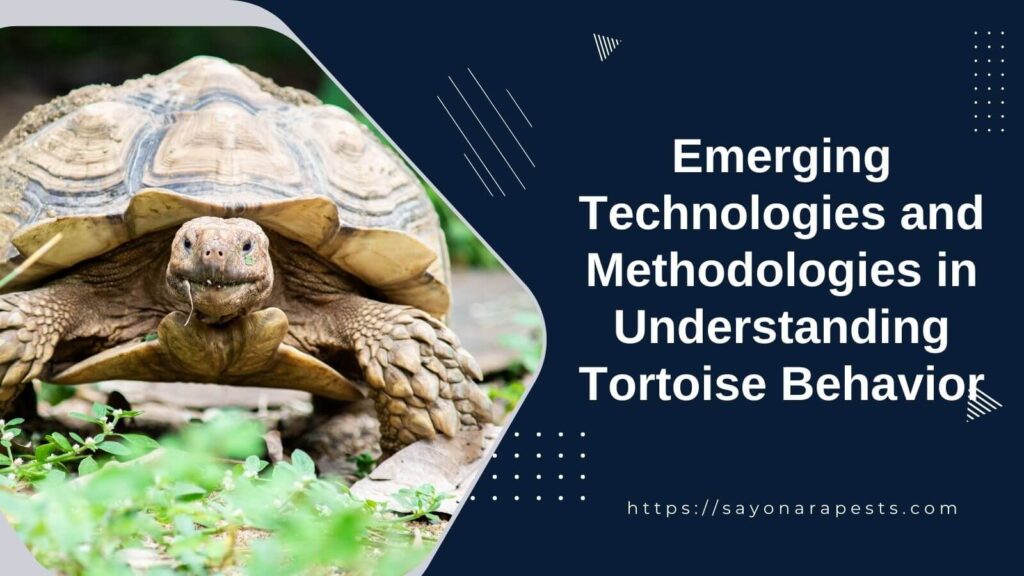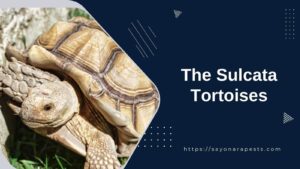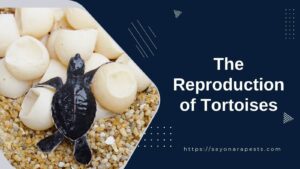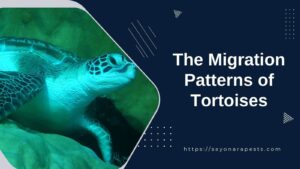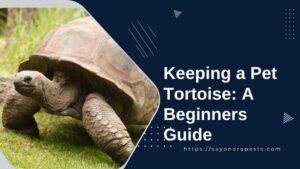In the vast world of science, the mysterious world of tortoise behavior has long been a source of interest for both researchers and science fans.
As the world sees a huge increase in new technologies and ways of doing things, a new frontier opens up in our understanding of these interesting creatures.
Exploring new technologies and methods is the key to figuring out how tortoises behave, which will give us important information about their ecology, physiology, and social interactions.
By exploring this uncharted territory, scientists will be able to learn more about how tortoises behave, which will give them access to a wealth of information that goes beyond simple curiosity and has important implications for conservation efforts and the way ecosystems are managed.
Embracing this cutting-edge frontier, the combination of state-of-the-art technologies and new methods promises to change the way we think about how tortoises act and reveal the untold stories behind their slow and steady lives
Traditional Methods of Studying Tortoise Behavior
Researchers and conservationists have been interested in how tortoises act for a long time. This has led to the development of many traditional ways to study these beautiful animals.
Researchers have learned a lot about how tortoises act in the wild, where they like to live, and how they interact with each other by using field observations and capture and telemetry techniques.
Researchers spend long periods of time in the field carefully watching tortoises in their natural environments. This method lets researchers study tortoises without getting in their way so they can get information about their behavior.
Researchers keep track of things like feeding, mating, nesting, and social interactions. This gives them valuable information about how tortoises spend their days and what they do.
Field observations are especially helpful for long-term studies that want to keep an eye on individual tortoises or groups of tortoises for a long time.
Tortoises are caught and given tags so that researchers can keep track of where they go and what they do. Usually, small radio transmitters or GPS devices are attached to the tortoises as part of this method.
This lets researchers track their movements and collect data from a distance. Telemetry gives detailed information about where tortoises live, how they move, and where they like to live.
By keeping track of individual tortoises over time, researchers can learn about their territoriality, how they find food, and how they react to changes in their environment.
Traditional methods have helped us learn a lot about how tortoises act, but there are some things they can’t do. Field observations can take a lot of time, and researchers may have to deal with difficult conditions.
Some behaviors, like nesting or courtship rituals, are hard to watch because they don’t happen often or in private places. Also, field observations may be biased because the presence of researchers can change how tortoises act in their natural environment.
On the other hand, techniques like capture and telemetry can hurt and stress out the tortoises. Capturing and tagging people can change how they normally act, which could affect their ability to stay alive and have children.
Also, telemetry devices have limits on how long their batteries last, how far they can reach, and how accurate they can be, which can affect the quality and length of the data collection.
New technologies and ways of doing things give us exciting chances to get around these problems and learn more about how tortoises act. For example, drones with high-resolution cameras and thermal imaging sensors can do detailed aerial surveys of tortoise habitats.
This lets researchers find out how many people live in an area, what the habitat is like, and even find tortoises that are hard to see on the ground because they hide or move quickly.
Researchers can also study the genetic diversity, relatedness, and population structure of tortoise populations now that they have better tools for genetic analysis and molecular techniques.
This information is important for making good plans to protect tortoises and for understanding how habitat fragmentation and human activities affect tortoise populations.
Also, using non-invasive tracking technologies like GPS collars or accelerometer tags can give accurate and continuous information about how tortoises move, what they do, and how they react to changes in their environment.
These technologies cause tortoises the least amount of stress while giving us important information about how they act over long periods of time.
Traditional ways to study tortoise behavior, such as field observations and capture and telemetry, have given us a lot of useful information about how they act in the wild.
But these methods aren’t perfect because they require a lot of time in the field, could be biased, are invasive, or are limited by technology. New technologies and methods can help us learn more about how tortoises act by giving us non-invasive, high-resolution data on habitat use, movement, genetic diversity, and how they react to environmental changes.
These improvements can make it much easier to protect tortoise populations and keep them alive for a long time.
Emerging Technologies for Studying Tortoise Behavior
In the past few years, researchers and conservationists have used new technologies to learn more about how tortoises act. These new tools give scientists new ways to learn about these amazing animals.
They can track their movements, record their sounds, and collect other useful information that can help protect and manage tortoise populations. GPS tracking and acoustic monitoring are two technologies that have been used a lot in this field.
GPS tracking has changed the way researchers study tortoise behavior by giving them accurate information about where they go and where they like to live.
By putting small GPS devices on the shells of tortoises, scientists can follow their movements in real-time and make a map of how they spend their days.
Researchers have been able to learn things about tortoise behavior that they didn’t know before, like where they like to eat, how they move, and what they do during different times of the year.
The GPS data can also be looked at together with things like temperature and humidity to learn more about how tortoises react to changes in their environment.
But it’s important to know that GPS tracking has its limits, especially in places with a lot of trees or rocks that can make it hard for satellites to reach. Still, this technology has helped us learn a lot more about how tortoises act and how they interact with their environment.
Acoustic monitoring is a new technology that has been used to study how tortoises act. Tortoises are known to make a wide range of sounds, which are important ways for them to communicate with each other.
For acoustic monitoring, special audio recording equipment is used to record and analyze these sounds. Researchers can learn about tortoises’ social structure, mating habits, and sense of territory by listening to and analyzing their calls.
The unique sounds that each tortoise makes can also help identify them through acoustic monitoring. This technology has the benefit of not being invasive and being able to keep an eye on things for a long time.
To figure out what tortoises are saying, though, you need to use advanced data analysis techniques. Sometimes, background noise from other animals or people can make it hard to interpret the data correctly.
Even with these problems, acoustic monitoring has shown to be a useful way to learn more about how tortoises act and interact with each other.
Several important studies have used these new technologies to find out more about how tortoises act in different ways.
For example, a research team in a desert tortoise habitat used GPS tracking to find out how the tortoises behaved based on the temperature and the amount of food they could find.
The data showed that tortoises change their daily movements in response to changes in temperature and actively look for places with more plants when it is very hot.
This information can help conservation efforts by showing how important it is to keep tortoises in places that are good for them as the climate changes.
In another study, acoustic monitoring was used to listen to the sounds that Galapagos giant tortoises make when they are trying to mate.
By listening to the recorded calls and figuring out what each one meant, researchers were able to tell the difference between mating calls and aggressive calls.
This helped scientists learn more about how these famous tortoises mate and gave them more information about how they have babies. This information can help people come up with ways to protect these species that are in danger.
The way we study how tortoises act has changed a lot because of new technologies like GPS tracking and acoustic monitoring.
These technologies have benefits like giving accurate information about movements and sounds, allowing for continuous monitoring, and revealing parts of tortoise behavior that were unknown before. But they aren’t perfect.
For example, it can be hard to figure out what the data means and there may be technical problems in some habitats.
Still, studies using these technologies have given us important information about how tortoises act, which has helped conservation efforts and given us a better understanding of these interesting animals.
As technology keeps getting better, it’s likely that even more new tools will be made, which will help us learn more about how tortoises act and help protect and manage them.
Novel Methodologies for Studying Tortoise Behavior
Researchers are always coming up with new ways to study how tortoises act, using cutting-edge methods like machine learning algorithms and biotelemetry.
Researchers can learn a lot about tortoises’ roles in the ecosystem, how they need to be protected, and their overall health and well-being by using these new ways of looking at their behavior.
Machine learning algorithms have become a powerful way to study the complicated patterns of behavior that tortoises show. By using a lot of data about how tortoises act, these algorithms can find and classify different kinds of behavior, like eating, sleeping, or mating.
Machine learning algorithms can learn from a huge amount of data and pick up on subtle changes in behavior that might be hard for humans to notice. Researchers can find complex patterns and links in tortoise behavior with the help of this automated analysis.
This gives them a better understanding of their daily activities, movement patterns, and social interactions.
Biotelemetry is another new method that uses high-tech devices and sensors that are attached to tortoises. These devices can track how tortoises move, where they like to live, and what the weather is like in real-time.
Researchers can learn a lot about tortoises’ habitat needs, migration patterns, and how they react to changes in their environment from the data they get from biotelemetry.
Also, biotelemetry can help us understand how tortoises act during important times of their lives, like when they are nesting or sleeping, when they are hard to watch directly.
There are many benefits that could come from using these methods. First of all, machine learning algorithms can quickly analyze a lot of data, which cuts down on the time and effort needed to study behavior.
This makes it easy for researchers to do large-scale studies that include a lot of people and populations. Scientists can figure out how climate, diet, or social dynamics affect behavior differences by looking at a wide range of tortoise species in different environments.
Because of this, these results can be used to make effective conservation plans that meet the needs of each tortoise species and population.
Biotelemetry, on the other hand, is a way to watch tortoises in their natural environments without hurting them. Researchers can learn a lot about how individual tortoises move and where they like to live over long periods of time by using tracking devices and sensors.
This long-term data can help make strong plans for protecting tortoise populations by pointing out their most important habitats, migration routes, and possible threats.
Also, biotelemetry lets researchers watch how tortoises act in real-time, giving them new information about how they react to changes in their environment and to people disturbing them.
Several ongoing studies show how these new ways of doing things can be used to learn more about how tortoises act.
For example, researchers have used machine learning algorithms to look at videos of tortoises to find and classify specific behaviors related to finding food, controlling their body temperature, or interacting with other tortoises.
These studies have found small differences in how different tortoise species act and have given us important information about their ecological roles in their own ecosystems.
In the same way, biotelemetry has been used in many studies to track how tortoises move across different landscapes.
By using GPS tracking devices and environmental sensors together, researchers have found out where tortoises like to live and travel when they are nesting or migrating. These kinds of studies have also shed light on how habitat fragmentation, climate change, and human disturbances affect the way tortoises act and how their populations change.
New ways to study tortoise behavior, like machine learning algorithms and biotelemetry, are making a big difference.
These cutting-edge techniques have a lot of benefits, such as making it easy to quickly analyze complex behavior patterns and getting real-time information about how tortoises move and where they like to live.
Using these methods in ongoing studies has already helped us learn more about how tortoises act, which helps with conservation efforts and the creation of more effective management plans.
Researchers can help protect and improve the long-term health of tortoise populations around the world by continuing to study and improve these methods.
Integrating Traditional and Emerging Technologies and Methodologies
Integrating traditional methods with new technologies and methods has a lot of potentials to help us learn more about how tortoises act. By combining these approaches, researchers can use the best parts of both tried-and-true methods and new, cutting-edge ideas.
This leads to studies that are both thorough and enlightening. This integration can lead to many benefits, such as better data collection, more accurate data, more research opportunities, and a deeper understanding of how tortoises act.
One big benefit of combining traditional methods with new technologies is that it makes it easier and more accurate to gather data. Observing tortoises in the wild and collecting data by hand have been important ways to study their behavior for a long time.
But new technologies like GPS tracking devices, remote sensing, and unmanned aerial vehicles (UAVs) give researchers more ways to track tortoise movements, where they like to live, and how they interact with their surroundings.
These technologies make it possible to collect a lot of data with a high level of detail. This lets researchers see small details that they might have missed with older methods.
By combining qualitative and quantitative data, a combination of traditional and new approaches can give a more complete picture of how tortoises act.
Traditional methods often rely on qualitative observations, such as descriptions of behavior and anecdotes, which give important information about how tortoises feel.
On the other hand, new technologies like sensors, cameras, and advanced monitoring systems give us quantitative data.
By combining these two kinds of data, researchers can get a complete picture of how tortoises act by taking into account both objective measurements and their own opinions.
Several studies have shown that combining traditional and new ways to study tortoise behavior is a good idea.
For example, a study that was published in the Journal of Herpetology used field observations and drone-based aerial surveys to find out how disturbing tortoise nesting sites were affecting the tortoises.
Researchers used traditional methods to find and keep an eye on nesting spots on the ground. High-resolution cameras on drones were used to take pictures of the nesting spots from above.
The combination of these methods made it possible to get a full picture of how tortoises behave when they are nesting, including how they move around, where they choose to nest, and what dangers they might face.
Another study, which was published in the journal Conservation Biology, used both traditional radio-telemetry tracking and advanced machine learning algorithms to look at how tortoises move around in landscapes that are broken up.
Researchers put radio transmitters on tortoises and used traditional methods to track where they went.
Then, they put this information together with techniques for machine learning to find the most important things, like habitat fragmentation and the availability of resources, that affect how tortoises move.
By combining these methods, the study gave important information about how tortoises react to changes in their environment, which helped conservation efforts.
Combining traditional methods with new technologies and methods can help researchers learn a lot about how tortoises act. By using both of these methods together, researchers can use the best parts of each to improve data collection, accuracy, and understanding.
Several studies have shown that qualitative and quantitative data can be combined successfully, which shows how important it is to do so to learn more about how tortoises act as a whole.
This multidisciplinary approach has a lot of potentials to help us learn more about how tortoises behave and figure out how to protect these well-known reptiles.
Challenges in Studying Tortoise Behavior with Emerging Technologies and Methodologies
Researchers face a unique set of challenges when they use new technologies and methods to study how tortoises act. Even though these new technologies offer exciting chances to learn more about how tortoises act, they also have their own limits and problems that must be solved.
This section talks about the different problems that researchers may run into when using new technologies and methods to study tortoise behavior. It also gives examples of studies that have run into these problems and found ways to solve them.
Choosing and using the right tracking devices is one of the most difficult parts of using new technologies to study tortoise behavior.
As technology keeps getting better, researchers have more tracking tools at their disposal, such as GPS trackers, accelerometers, and radio transmitters.
But it can be hard to choose the right device that can accurately track how tortoises move without getting in the way of how they normally act.
For example, the size and weight of the tracking devices could make it hard for the tortoise to move around or make it feel uncomfortable, which could change their behavior.
To deal with this problem, scientists have made tracking devices for tortoises that are small, light and don’t hurt them too much. These things are carefully attached to the tortoise’s shell or limbs so that their movements aren’t too much affected.
Researchers also have to figure out how to make sense of the data they get from new technologies. The huge amount of data that tracking devices produce can be overwhelming and hard to figure out.
For example, GPS data can give a lot of information about the tortoise’s movement patterns, habitat use, and home range, but it takes advanced analytical techniques to get useful information from this data.
Researchers have solved this problem by using advanced tools for spatial analysis and statistical models to figure out the complicated patterns in how tortoises act.
Researchers have found complex links between how tortoises act and things in their environment by combining data from different sources and using machine learning algorithms.
Using new technologies to study tortoise behavior is hard because of concerns about ethics and animal welfare. Researchers must make sure that the tortoises in the study are not hurt or upset by their methods.
For example, catching and handling tortoises to attach devices can be stressful for the animals and could change how they act during the study.
To deal with this problem, researchers have set up strict rules for how to handle animals and attach devices so that the tortoises feel as little stress and pain as possible.
During the study, they also keep a close eye on the tortoises to spot any signs of distress and act quickly if needed.
When using new technologies to study tortoise behavior, the environment in which they live can also make things hard. Tortoises live in many different kinds of ecosystems, from deserts to forests, and each one has its own challenges.
Extreme temperatures, rough terrain, and lots of plants can all affect how well tracking devices work and how reliable they are. To solve this problem, researchers have made tracking devices that are strong and can stand up to bad weather and other harsh conditions.
They have also set up field testing and calibration procedures to make sure that the data they collect is accurate and reliable.
Using new technologies and methods to study how tortoises act is not without its challenges. Researchers face challenges when they have to choose and use the right tracking devices, make sense of complicated data, think about ethics, and deal with environmental limits.
But researchers have been able to solve these problems by coming up with new ideas and being very careful about how the animals are treated.
As technology and methods improve, we continue to learn more about how tortoises act, which helps with their conservation and management.
Ethical Considerations
When using new technologies and methods to study tortoise behavior, it is important to think about the ethical issues that come up. Tortoises are fascinating animals that play an important role in their ecosystems.
Any research on tortoises must put their health and the protection of their homes at the top of its list. To make sure they are acting in an ethical way, researchers need to take a number of steps that limit the harm they do to tortoises and their environments.
First and foremost, it is important to have a lot of respect for the tortoises that are being studied. Tortoises are living creatures that deserve care and kindness.
Researchers should know how valuable they are and realize that their work is both a privilege and a duty. This way of thinking is the basis for doing research in an ethical way.
To avoid hurting tortoises and their habitats as little as possible, it’s important to focus on non-invasive methods. Researchers should try to learn what they need to know without hurting or upsetting the tortoises.
Remote sensing technologies, such as drones or satellite imagery, could be used to watch tortoise populations and how they act without harming them.
By using these methods that don’t bother the tortoises, researchers can get useful information while disturbing their natural behavior as little as possible.
Also, ethical concerns should be taken into account when protecting tortoise habitats. Researchers need to think about how their work might affect the ecosystems where tortoises live.
This means taking care not to destroy habitats, not bringing in invasive species, and causing as little trouble as possible to the delicate balance of the environment.
Researchers should also work with local communities and conservation groups to make sure that their study fits in with larger conservation efforts and helps protect tortoises and their habitats for the long term.
Several important studies have dealt with the ethical issues that come up when studying tortoise behavior. These studies can be used as models for future research.
One of these studies looked at what happens to tortoise populations when people mess with them in a protected reserve. Researchers used both remote camera traps and acoustic monitoring to study how tortoises act and look for signs that they might be stressed.
This non-invasive method made it possible to get accurate data without bothering the tortoises. In the end, this helped protect their habitats by making people aware of the effects of human activities.
Another example is a study that looked at how climate change affects where tortoises lay their eggs. In this study, satellite tracking devices were used to keep track of where tortoises went and how they built their nests.
Using this technology, they were able to learn important things about how climate change affects the way tortoises have babies. This information not only helps us learn more about the species but also gives us a place to start when making plans to protect it.
The ethical issues that come up when using new technologies and methods to study tortoise behavior are of the utmost importance. Researchers must treat the tortoises and their homes with respect and use methods that don’t hurt them or their homes as much as possible.
Researchers can help protect these beautiful animals and their ecosystems by putting the well-being of tortoises first and working with groups that work to protect them.
The examples of successful studies show how ethical research methods can help us learn more about how tortoises act and support conservation efforts at the same time.
In conclusion, studying how tortoises act is very important for figuring out what makes these mysterious animals behave. Through careful research and observation, we learn a lot about their roles in the ecosystem, how to protect them, and how they have changed over time.
Also, changes in technology and methods have changed the way we think about how tortoises act, making the field move forward with speed and accuracy that has never been seen before.
Scientists have been able to learn more about the complicated ways tortoises act by using new technologies like GPS tracking, remote sensing, and molecular genetics.
These new tools give us a unique view that lets us learn more than ever before about how they move, where they like to live, and how they react to changes in their environment.
By using the power of these technologies, we can improve conservation efforts, reduce conflicts between people and wildlife, and come up with good plans to help tortoise populations stay alive in the long run.
In the future, it will be important to keep pushing the limits of research into how tortoises act. If we learn more about how these ancient reptiles interact with each other, how they talk to each other, and how they reproduce, we will have a better understanding of their fascinating lives.
Collaborations between experts in biology, ecology, genetics, and technology will almost certainly lead to amazing discoveries and shed light on parts of tortoise behavior that haven’t been studied before.
In the end, the study of tortoise behavior is a fascinating field that combines scientific inquiry, technological innovation, and conservation goals.
By recognizing how important these amazing animals are and spending money on thorough research, we can make sure they will be around for a long time and help protect biodiversity around the world.
There is a lot of hope for the future because there are so many new areas to explore and so many new things to learn about how tortoises act.

